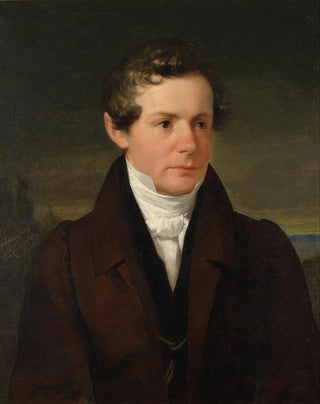Art print | Portrait of Dr. Stephan Schroff - Friedrich von Amerling


View from behind

Frame (optional)
Portrait of Dr. Stephan Schroff - Friedrich von Amerling – Captivating Introduction
In the world of art, some works transcend mere images to become witnesses of an era, reflections of the human psyche. The "Portrait of Dr. Stephan Schroff" by Friedrich von Amerling embodies this duality, blending technical finesse with emotional depth. This portrait, created in the 19th century, immerses us in the universe of a doctor whose gaze, both penetrating and serene, invites contemplation. Through this art print, we have the opportunity to explore not only the artist's virtuosity but also the historical and cultural context that shaped this iconic work.
Style and uniqueness of the work
Friedrich von Amerling's style is distinguished by a realistic approach, combined with romantic sensitivity. In the "Portrait of Dr. Stephan Schroff," every detail is meticulously crafted. The nuances of light and shadow play across the doctor's face, emphasizing his gentle and thoughtful expression. The choice of colors, both warm and soothing, creates an intimate atmosphere that invites the viewer to come closer. Amerling excels in depicting textures, whether through the delicate rendering of skin or the richness of fabrics that dress his subject. This art print does not merely depict an individual; it captures the very essence of humanity, revealing rare psychological depth. The way Dr. Schroff's gaze seems to follow the viewer, engaging in a silent dialogue, testifies to Amerling's genius in immortalizing not only an appearance but also a soul.
The artist and his influence
Friedrich von Amerling, born in 1803 in Vienna, is one of the most respected portraitists of his time. His work, nourished by influences of classicism and romanticism, marked an era when art was meant to reflect society while rising above simple representations. Amerling succeeded in establishing himself through his talent for capturing the personality of his subjects, a trait that enabled him to create portraits of prominent figures of his era. His technique, combining precision and sensitivity, inspired many contemporary and later artists, who saw in him

Matte finish

View from behind

Frame (optional)
Portrait of Dr. Stephan Schroff - Friedrich von Amerling – Captivating Introduction
In the world of art, some works transcend mere images to become witnesses of an era, reflections of the human psyche. The "Portrait of Dr. Stephan Schroff" by Friedrich von Amerling embodies this duality, blending technical finesse with emotional depth. This portrait, created in the 19th century, immerses us in the universe of a doctor whose gaze, both penetrating and serene, invites contemplation. Through this art print, we have the opportunity to explore not only the artist's virtuosity but also the historical and cultural context that shaped this iconic work.
Style and uniqueness of the work
Friedrich von Amerling's style is distinguished by a realistic approach, combined with romantic sensitivity. In the "Portrait of Dr. Stephan Schroff," every detail is meticulously crafted. The nuances of light and shadow play across the doctor's face, emphasizing his gentle and thoughtful expression. The choice of colors, both warm and soothing, creates an intimate atmosphere that invites the viewer to come closer. Amerling excels in depicting textures, whether through the delicate rendering of skin or the richness of fabrics that dress his subject. This art print does not merely depict an individual; it captures the very essence of humanity, revealing rare psychological depth. The way Dr. Schroff's gaze seems to follow the viewer, engaging in a silent dialogue, testifies to Amerling's genius in immortalizing not only an appearance but also a soul.
The artist and his influence
Friedrich von Amerling, born in 1803 in Vienna, is one of the most respected portraitists of his time. His work, nourished by influences of classicism and romanticism, marked an era when art was meant to reflect society while rising above simple representations. Amerling succeeded in establishing himself through his talent for capturing the personality of his subjects, a trait that enabled him to create portraits of prominent figures of his era. His technique, combining precision and sensitivity, inspired many contemporary and later artists, who saw in him






